2016 through its changes in terms and conditions
In October of 2015, we launched the first fruit of our Legal LAB, the Tracker of Terms and Conditions. It was a tool to track changes in terms and conditions. Although it wasn’t perfect, through it we were trying to reach a goal that seemed reasonable and useful: to know when and how the services change their terms and conditions.
So, the Tracker of Terms and Conditions was born.
But, why is it important to know how and when the services change their terms and conditions? Because at the end of the day, the terms and conditions are a contract. A contract that it is established by one of the parties, usually the company, and the user can only accept o reject the content. So, the user does not have the option to negotiate the terms.
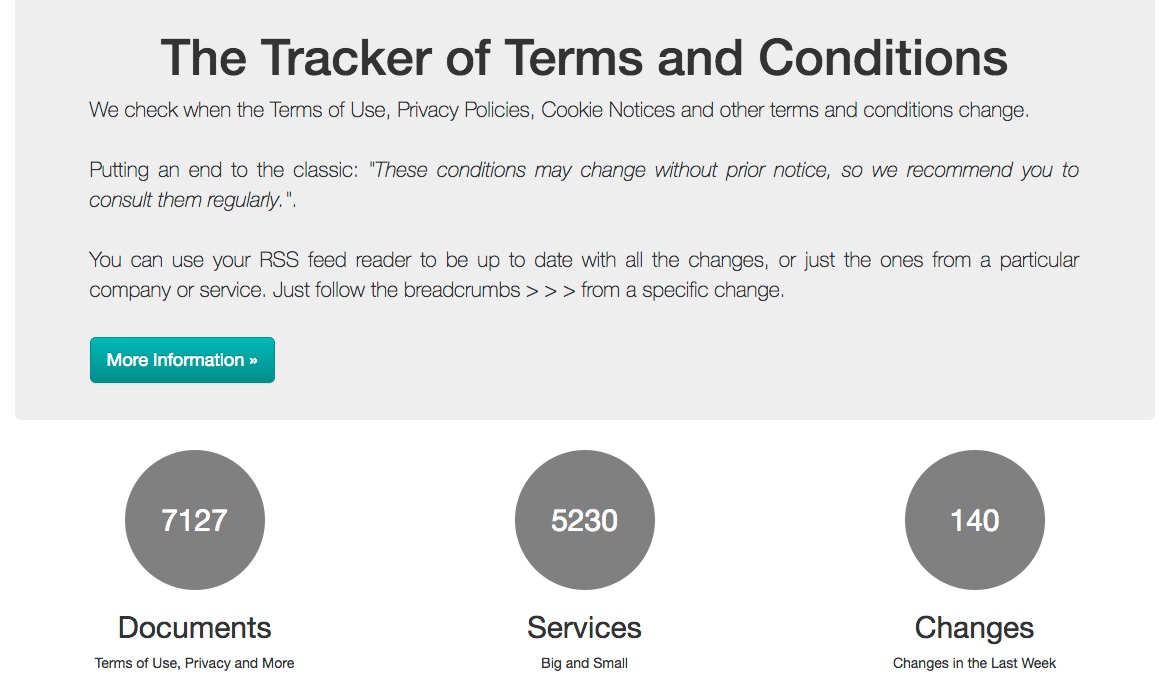
This contract creates rights and obligations for both parties, but only one party has control over them (the company). Even though the law protects the user against plenty of unfair practices that the company may try to introduce through the terms and conditions, not all of them are reported. Besides, there are modifications on the legal texts of a storing, messaging or hosting service that are important to it but not unfair.
In summary, to know when and how the terms and conditions change, can be useful and good to: 1) report unfair practices according to the law and; 2) to find out about some of the surprises that the small print can include.
We love to track how the terms and conditions change (a little too much, maybe) :p, that’s why we follow them daily and from time to time we highlight the important ones. In fact, thanks to that we «announced» that Apple had bought Topsy 5 days before the official announcement (Topsy changed its Privacy Policy too soon). In any case, during a full year plenty of changes happen, and in 2016 we have tracked more than a few. To be precise, during 2016 we have detected 10.512 changes in terms and conditions.
However, before we start looking at the data, what do we understand as a «change»? Well, when there is a modification on a legal text such as Terms of Use, Privacy Policy, Cookie Policy or some other text that could be understood as terms and conditions (more than a few).
If the change is normal (a grammar mistake was fixed, a comma added or some text was translated from English to Spanish, for example), that’s a non-important change.
If the change goes beyond fixing a mistake (it adds or modifies rights and obligations for the user), then we take into account if the date from the «Last Update» section was updated too. Because that would be useful for a user who would want to know if that text has been modified from its last visit.
Let’s not forget that the terms and conditions usually say that we should check them regularly to see if something has been added or changed. Perfect, but they should provide some sign of it, right? Well, that’s what we track.
Having said that, if the change did not modify the «Last Update» section, we tag that change as Bad or an important modification that was not notified to the user.
If the change updated the date from that section, then we tag the change as Good or an important modification that was notified to the user.
And now, let’s check some data about the changes that we tracked in terms and conditions during 2016.
1.- The trend during the year
We detected 876 changes per month. Taking into account that right now we track a little bit more than 5.200 services, not bad! September, with August, were the most active months, especially thanks to Privacy Shield coming into effect (although I’m sure that the holidays had also some effect there).
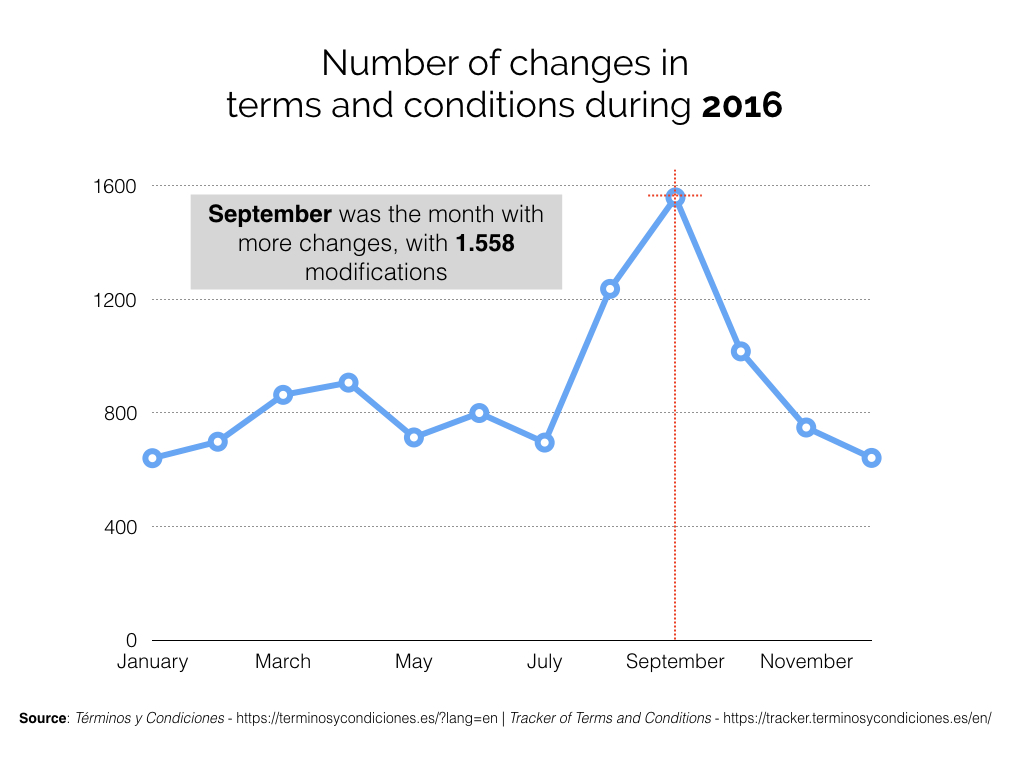
Therefore, if September was the most active month, there are no surprises and the most active Day and Week are from September, too.
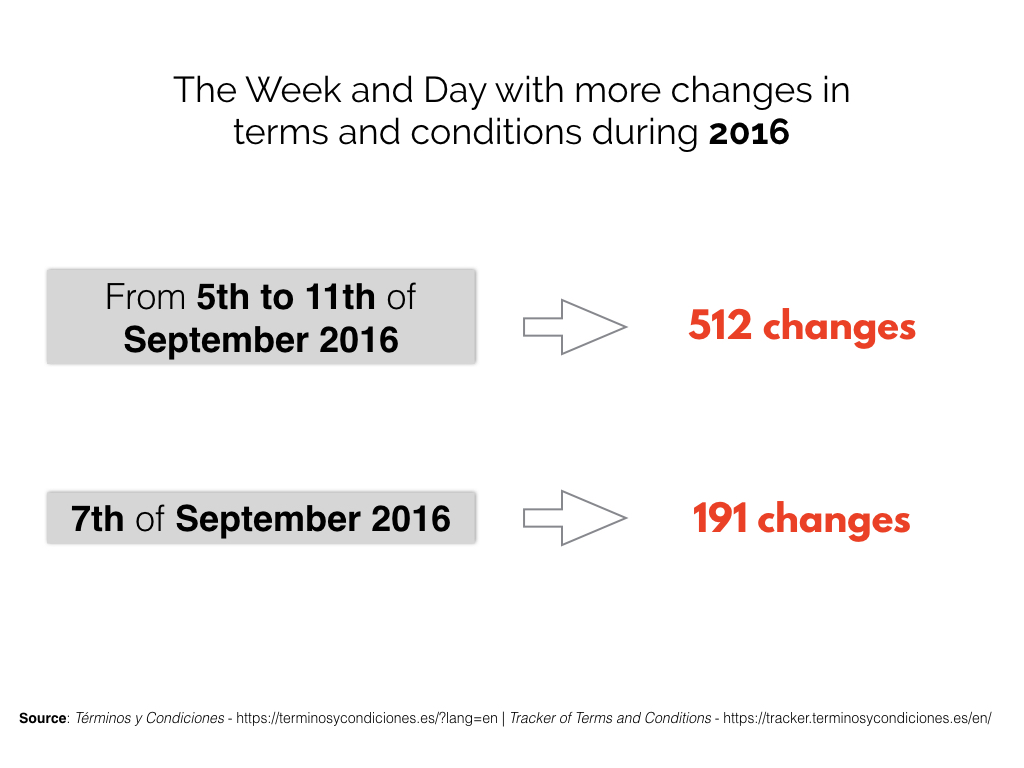 Going back to the Privacy Shield effect, it definitively was the legal event with the biggest impact in terms and conditions in 2016. After so many months of uncertainty once Safe Harbor was invalidated, it seems that when the new legal framework was approved as the instrument for international data transfers, plenty of services started to update their Privacy Policies. With August and September being the peak.
Going back to the Privacy Shield effect, it definitively was the legal event with the biggest impact in terms and conditions in 2016. After so many months of uncertainty once Safe Harbor was invalidated, it seems that when the new legal framework was approved as the instrument for international data transfers, plenty of services started to update their Privacy Policies. With August and September being the peak.
This is something that we can affirm with certainty. The thing is that since Safe Harbor was invalidated, we have been tracking the terms and conditions of more than 90% of the services adhered to it.
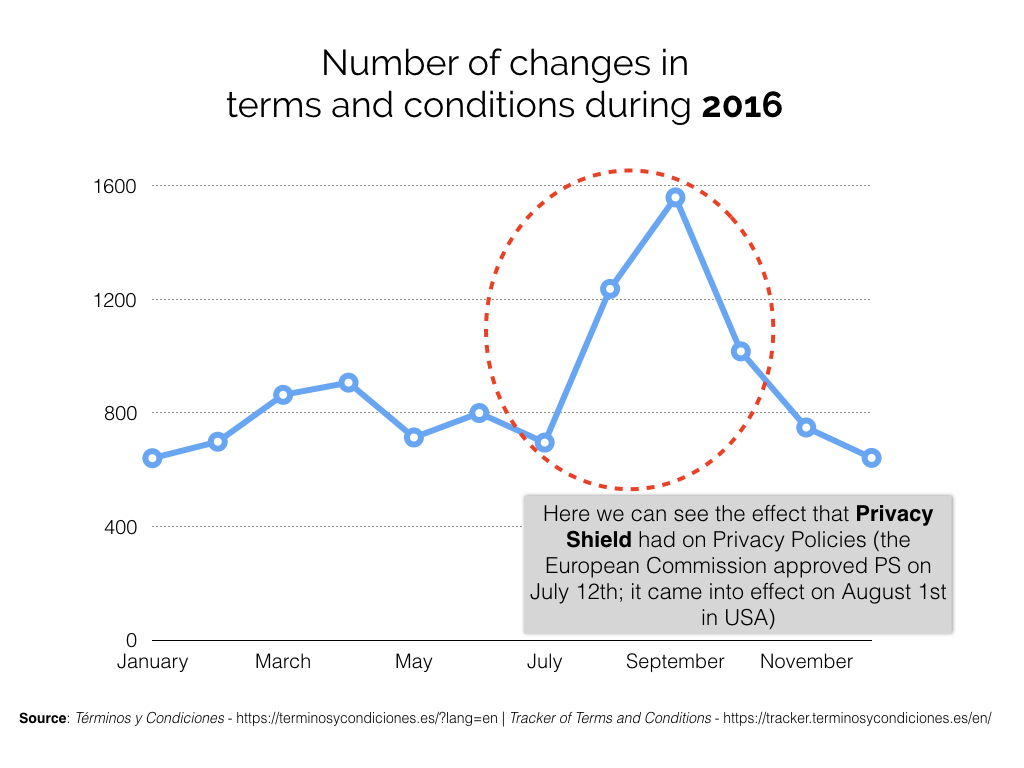
2.- Who changed them more?
Truth be told, it’s a tricky question to answer.
We track a little bit more than 5.200 services and more than 7.100 texts. It’s not a lot, taking into account how many terms and conditions are out there, but we think that is a good number to get some useful data.
However, we track texts in Spanish and English, usually from the same service. Why? For starters, we are from Spain. So first we want to track the terms and conditions that are closer to us. So, we always track the Spanish version.
On big services, we also track the English version. So, we can see if there are differences between the main version and a country specific one (and there are differences). For example, last year Facebook introduced some changes on its Payments Terms, but only the English version was changed, not the Spanish one. Likewise, during 2016 Google has updated its Privacy Policy in Spanish, but no in English.
In addition, it’s not always easy to separate the Terms of Use and the Privacy Policy of a service. Because although each text uses a different URL, they share the same website.
Therefore, sometimes we get duplicates from a change, because the Spanish and English versions change equally. But that is not always the case. So, we try to control as much as we can to get the full picture.
Nevertheless, that makes it harder to get the usual ranking about who changed more their terms and conditions.
For that reason, we have created different charts that show different aspects of the changes tracked: on a global escale, changes notified to the user and changes not notified.
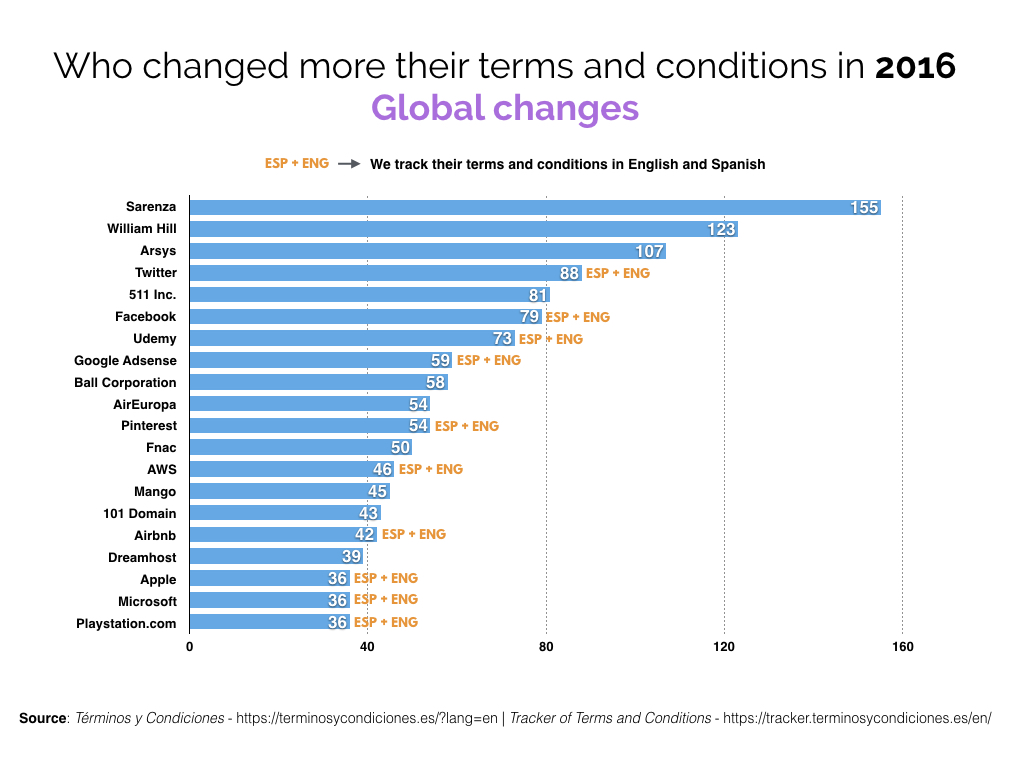
This ranking takes into account all the changes detected, including Normal, Good and Bad ones. This way, we can see what service was more active on a global escale during 2016. But as you can see, we point out the services where we track the Spanish and English versions. So, where we could expect more duplicates.
In any case, those remarkable numbers, especially in some cases, always have an explanation.
For example, Sarenza changes almost daily some texts because they update the conditions of their promotions regularly. And that’s why they are at the head of the pack. William Hill has plenty of terms and conditions, but in addition to that, the Super Suplente Promotion Policy changed almost daily during months some of its content (the matches affected by the promotion). At the end of the day, that brought 84 extra changes. :p Arsys modified its website and that produced plenty of small changes, the non-important ones, but that were taken into account. Udemy, between English and Spanish texts being tracked, plus the translations of some of its clauses, rose quite a bit.
And on every service there is a story.
Therefore, we could say that this is the ranking of the services that made us work more.
Now, let’s take a look to the changes that were not notified to the user. In that case, who was the worse one? I mean, what services changed more its terms and conditions on an important way without pointing that out at all.
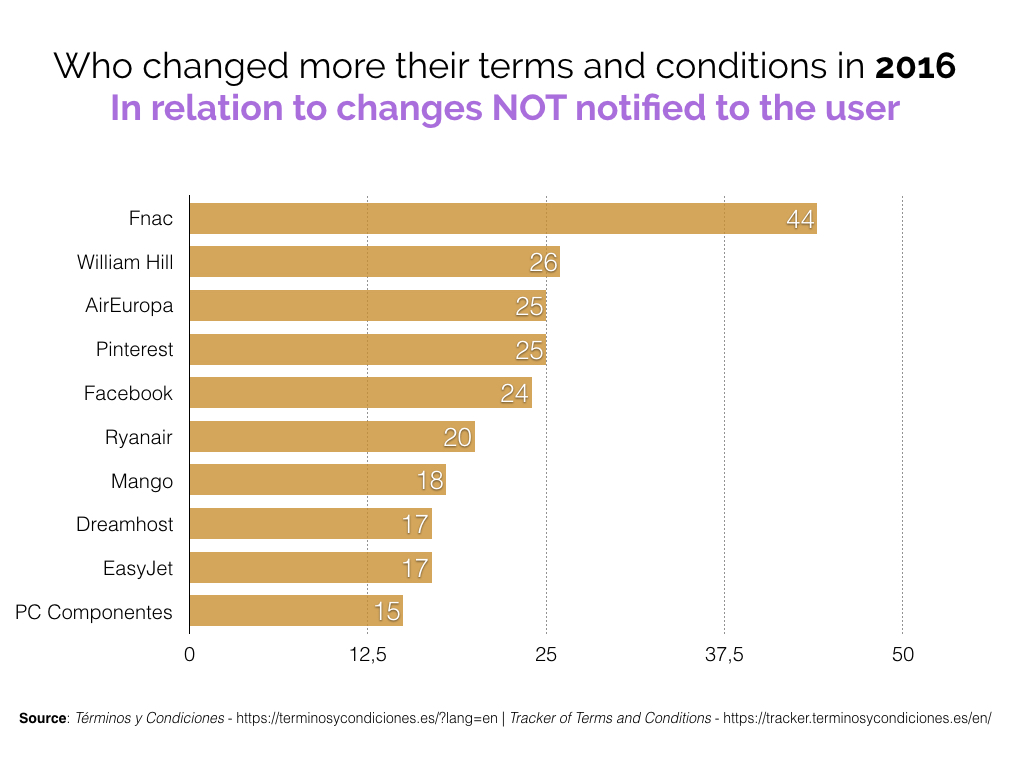
In this case, Fnac would be the leader. The service changes regularly terms and conditions, but the funny thing is that those texts don’t even include a «Last Update» section. Although truth be told, a change from Fnac usually affects 2-3 of their texts. So, there are some duplicates in that final number. But at the end of the day, those are changes on different texts, and that’s why we count them.
On the other hand, Pinterest is an interesting case. The service rarely does a change in terms and conditions without alerting the user. But they have two policies (the Acceptable Use Policy and the Advertising Guidelines) that change regularly and without notifying the user. That’s why the service is in this ranking.
Finally, I think it’s important to point out that in this Top 10 there are 3 airlines. Although AirEuropa includes some duplicates for the special format of their terms and conditions, without taking them into account it was still in the ranking. It seems like the transport terms from airlines need some extra attention.
Finally, who was the most trustworthy? I mean, who changed more their terms and conditions on an important way, but always notified the users about it.
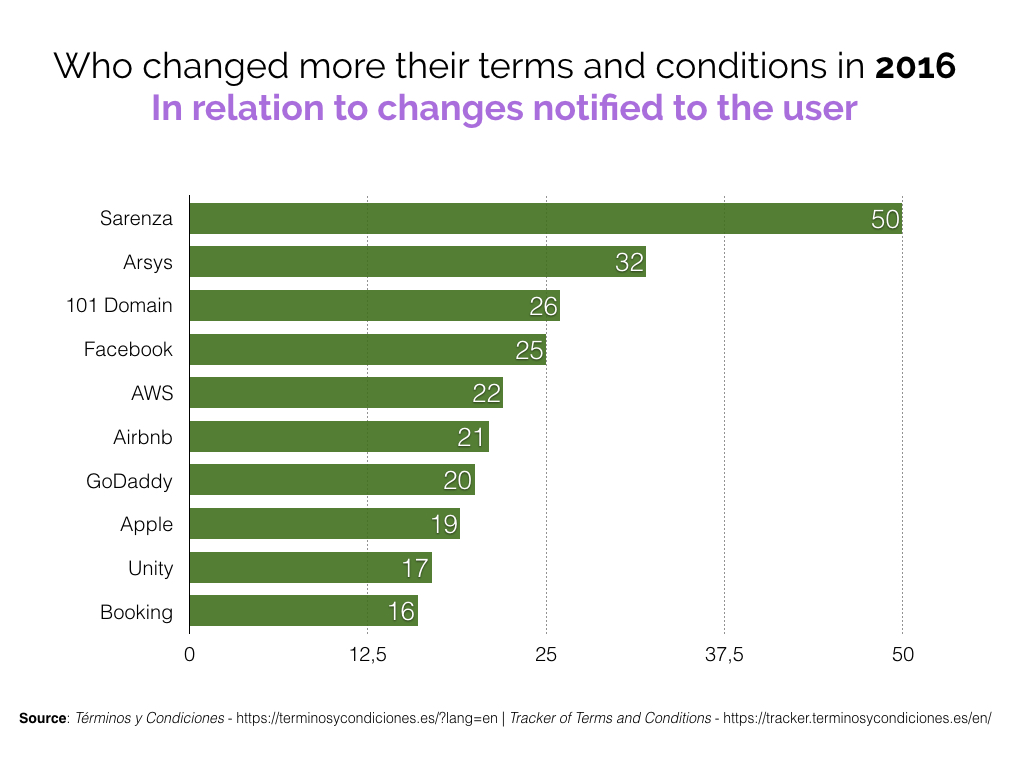
Sarenza also leads the pack here. And although the most usual changes from Sarenza are the non-important ones, it’s good to know that they notify the user. Arsys is trustworthy too. As well as Amazon Web Services (AWS) or Go Daddy, one of the few services that notified every change done during 2016. Facebook, although is number 6 in the global ranking, rarely does a big change in terms an conditions without giving notice. At least, on the big texts (the less important ones include more non-notified modifications). Unity is very reliable too, as well as Booking. On the other hand, Apple is an interesting case. The company does not change a lot their terms and conditions. And their changes are extremely well notified. But there are some lesser known polices that are updated very regularly, such as the Trademark List. That’s why Apple is on the list, mainly.
Something that deserves some extra attention, is the fact that on this ranking there are 4 providers of hosting (AWS, Go Daddy, Arsys and 101 Domain). Therefore, we could say that some of the most trustworthy services in relation to changes in terms and conditions are hosting services. After all, they do an important job and the level of transparency is up to the task.
3.- Conclusions
All in all, we detected 10.512 changes in terms and conditions during 2016. Those numbers can be reduced to:
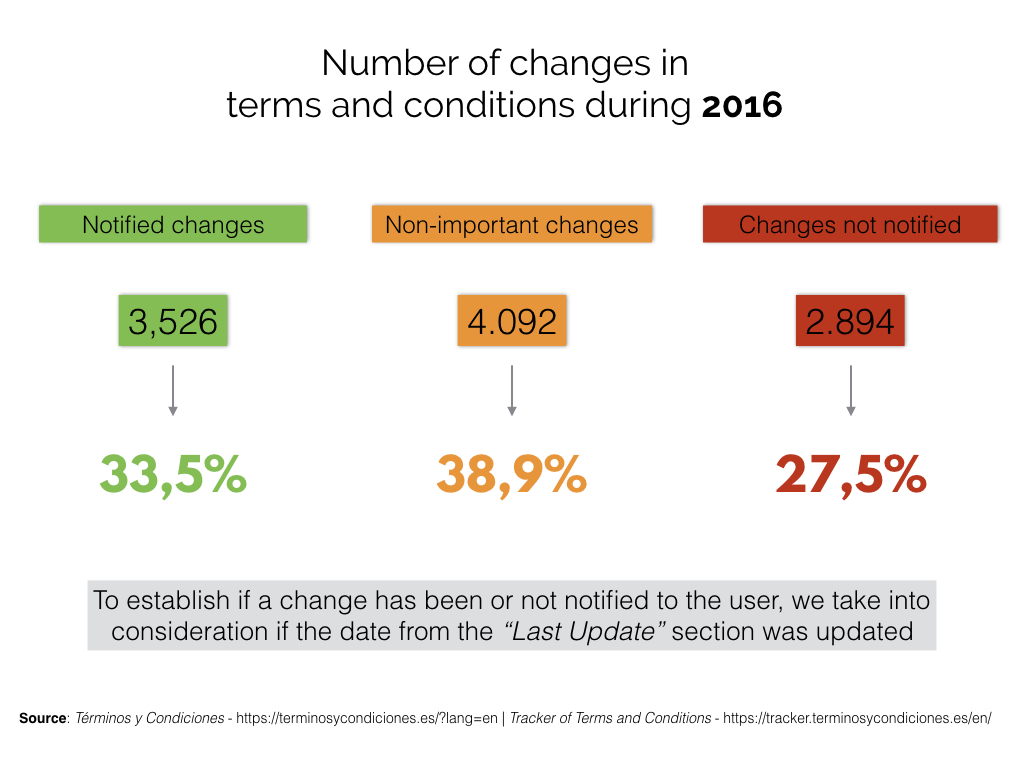
Obviously, the non-important changes win. But more significant, the important changes that were notified to the users exceed the ones that weren’t. In fact, if we just focus on the important changes, notified or not, we could reduce everything to:
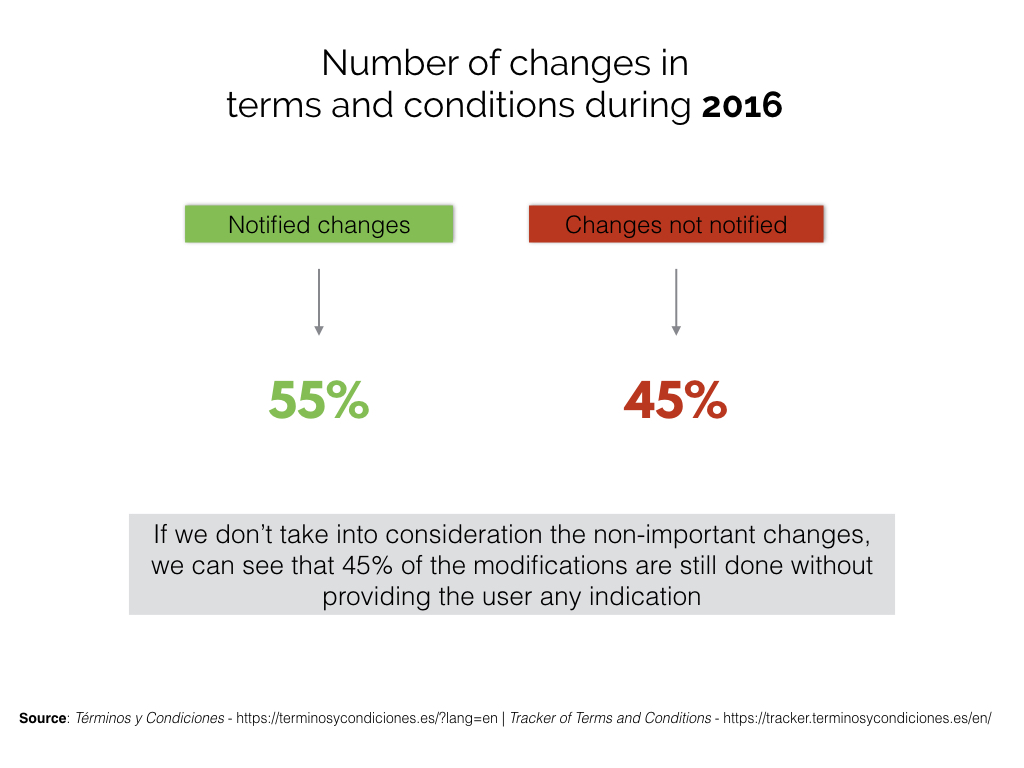
Therefore, during 2016 the services notified the users 55% of the times when an important change was introduced on their terms and conditions. Definitively not bad, especially taking into account that in the report that we did in 2014 (although with only 946 changes back then), only 44% of the important changes were notified to the users. So, we could say that there is an improvement.
In any case, the comparison will be more useful in 2017, when the amount of data to compare will be more similar.
In the end, we also have to say that there have been important and well known services that notified 100% of their important changes in 2016. For example: WhatsApp (although only had 1 :p), Go Daddy with 20, Snapchat with 12, Google with 16 (including Spanish and English), Spotify with 12 (including Spanish and English), Skype with 16 or SuperCell with 13.
Some of those services made important changes on their terms and conditions last year, and in some cases that caused more than a few headlines. But I think it’s important to point out that even in those cases, the services were very transparent about them.
In summary, we could provide way more data about changes in terms and conditions (among others, by industries, taking into account a period of time or according to the effect of a new law on the way the terms and conditions changed) And we will probably do it during 2017. But as a recap of 2016 in relation to terms and conditions, we think this is a good overview.
The good news is that 55% of the important changes were notified to the user. The bad news is that there are still 45% of those changes that gave no notice at all.
We’ll have to keep an eye on during 2017 too.
Happy new year!
—–
